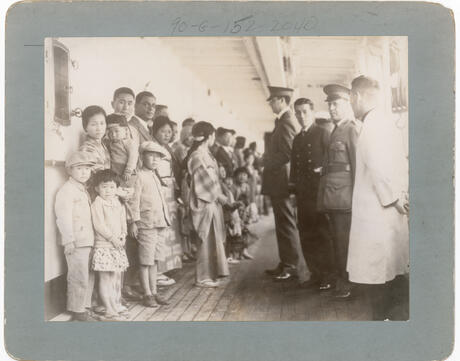
Confronting the Legacy of Chinese Exclusion
On May 6, 1882, nearly 141 years ago to the day, the U.S. Congress passed the Chinese Exclusion Act, a law unlike any other in U.S. history. The act, which was not repealed until 1943, banned all Chinese laborers from immigrating to the country and declared Chinese ineligible for U.S. citizenship. Nearly overnight the nation went from having what historians refer to as an “open door” policy toward immigrants to excluding an entire group of people on the basis of race and national origin.
The history of Chinese exclusion presents an important opportunity for students to explore how previous generations have answered the question, “Who can become American?” As students will learn in our new inquiry Angel Island Immigration Station: Exploring Borders and Belonging in US History, the singling out of Chinese immigrants in 1882 -- as opposed to English, Irish, or German immigrants who came in waves before the Chinese -- rested on the belief that the Chinese were perpetual foreigners who would always remain outside of the nation’s imagined community. As the Republican congressman from California William Higby argued in 1866,"The Chinese are nothing but a pagan race...You cannot make good citizens of them." 1
Such views also explain the disparate treatment immigrants received at the gates of the nation. While most Americans think of the Ellis Island immigration station in New York as a haven for “huddled masses yearning to breathe free,” the immigrant experience for Chinese arriving at Angel Island immigration station in San Francisco was very different. Historian Erika Lee writes:
While popularly called the “Ellis Island of the West,” the immigration station on Angel Island was in fact very different from its counterpart in New York. Ellis Island, mainly a processing center for European immigrants, was governed by American immigration laws that restricted but did not exclude European immigrants...Immigrants on Ellis Island usually only spent a few hours at the island depot whereas Asians, and particularly Chinese, on Angel Island counted their detention in weeks, months and even years. Ellis Island was a processing station of entry, but Angel Island’s purpose was to keep immigrants out. 2
In the face of tremendous barriers built by exclusion, Chinese immigrants still found ways to make a life in the United States. In our inquiry, students reflect on the choices and dilemmas of immigrants who entered the country using fraudulent papers, under what is known as the “paper son” system. They explore how the actions of “paper sons” involved making a claim to their rightful membership in American society and resisting unjust laws intended to keep them out. These choices ensured that their family members and future generations could settle in the nation. They represented a direct challenge to the exclusionary view of American identity embedded in the nation’s immigration laws. As one Chinese American merchant who helped paper sons enter the country explained, “God never said that the Chinaman 3 shouldn't come to this country.” 4
Despite this resistance, the policies of Chinese exclusion led to an increasingly narrow definition of who could become American. Chinese exclusion set a precedent of racially targeted exclusions that sharply limited the immigration of other immigrant groups, including most Asians and some Europeans. According to historian Roger Daniels, the Exclusion Act was “the pivot on which all American immigration policy turned, the hinge on which Emma Lazarus’s “Golden Door” began to swing toward a closed position.” 5 That door would stay closed until the post-World War II era and passage of the Immigration and Nationality Act of 1965.
Scholar Ben Railton describes this history as a battle between an inclusive and exclusive definition of national identity, one which has “re-emerged with particular clarity” in our present moment. Railton writes in his book “We the People,”
[T]he American “we” has consistently moved between...two poles. An exclusionary one, where the “we” is defined as one particular national community and contrasted with groups that are not part of it (who thus become “thems”), and an inclusive one, where all those groups are instead part of the “we” and the community it invokes. 6
Facing History’s inquiry on Angel Island Immigration Station explores these two poles by examining exclusionary laws and policies alongside the determination of immigrants to become full and equal citizens. This juxtaposition can help students reflect on the many factors that influence the choices we make about one another. These choices define identities, create communities, and ultimately forge a nation. They build on the work of earlier generations and leave a legacy for those to come.
- 1CONG. GLOBE, 39th Cong., 1st Sess. 1056 (1866).
- 2Erika Lee, At America's Gates: Chinese Immigration during the Exclusion Era, 1882-1943 (University of North Carolina Press, 2003), 75.
- 3While the use of “Chinaman” is offensive and antiquated today, it was used as a standard term for people of Chinese descent during this time.
- 4Quoted in Lee, At America's Gates: Chinese Immigration during the Exclusion Era, 1882-1943, 193.
- 5Roger Daniels, Guarding the Golden Door: American Immigration Policy and Immigrants since 1882 (New York: Hill and Wang, 2004) (p.19)
- 6Ben Railton, We the People: The 500-Year Battle Over Who Is American (Rowman and Littlefield, 2019), 1.

